Welcome to the
GRAHAM GREEN GALLERY

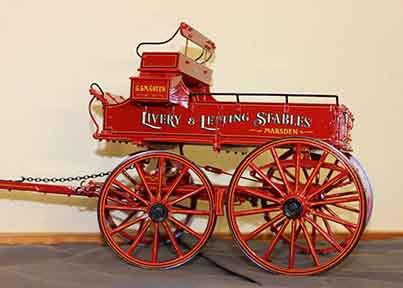 raham Green is from Brisbane, Australia. Included in this gallery is a small selection of 1/12th scale Model Horse Drawn Vehicles that he has made.
They are all totally scratch built, using what ever medium he can get his hands on to make them, that will look OK when the model is finished.
raham Green is from Brisbane, Australia. Included in this gallery is a small selection of 1/12th scale Model Horse Drawn Vehicles that he has made.
They are all totally scratch built, using what ever medium he can get his hands on to make them, that will look OK when the model is finished.
Graham tries and finishes them, so that they are close to historically correct, as he can possibly get them.
Graham describes his process: The majority of these models are made from the original working drawings that were published in The Coachbuilder and Wheelwright, by J.E.Bishop, from 1880 thru to 1925, these working drawings are what the original vehicle builders used to make the full sized vehicles. These drawings have every detail that is required for the full sized vehicle including showing where every nut and bolt has to go.
If I don’t have any working drawing for a model vehicle that I want to make, and I have access to the full sized vehicle, then I’ll take hundreds of photo’s and lot’s of measurements. Head home and then draw it to scale, adding every detail that I can see on the photo’s and make it from that drawing
I make every nut and bolt for the models, mainly 12 BA sized, but I do use 8 BA, 10 BA and 14 BA as well, I even had to make a nut making machine, so I can make the nuts by the thousands.
All the small coach-bolts are hand made on a lathe using bronzing rod, much harder than just plain brass, cuts easier and takes a thread without breaking off like brass does.
The wheels are all made in a similar detail as to what John Thompson recommends in his Scale Model Horse Drawn books, the only difference is I use perspex for the fellies instead of making the fellies from timber, much stronger using perspex and once painted you cannot see what they are made from. You can see how I make the wheels at this FaceBook page.
The main material that I use in the construction of the models is a timber called Tasmanian Myrtle, ( Nothofagus Cunninghamii ), it has a very close grain structure and there are NO pore holes in the timber to ruin a fine finish, it even takes a coat of paint like a piece of styrene plastic, with virtually NO grain lifting when painted, B-O-N-U-S, eh.
The other mediums I use are Brass, either rod or sheet of varying thickness, another excellent medium is Acrylic, Aluminum is used where I need strength and lightness and whatever else will do, that I can find to do the job that’s required. I do use a tad of Modelers License when ever I can get away with it.
Painting is done only ever using ENAMEL paints, it’s applied with an El-Cheapo airbrush, they work exactly the same as the most expensive one does, just blows paint around onto places you want it.
The fancy pin striping and lettering is all done with decals, I use an ALPS MD 5500 printer to make the decals.
I will try and use any original pin striping or lettering that I can come across, from anywhere, that way the finished model really does look the genuine article, not some toy.
Each vehicle description includes the name of each different type of vehicle and where Graham got the plans from.
These 1/12th scale models could be used with any Classic sized Breyers.
Graham does not offer his creations for sale, "just make ‘em and stash ‘em away in me glass cabinet for my perusal."
The only site he puts anything now is the Facebook group Scale Model Horse Drawn stuff.
Photo Credit: Country Storekeepers Wagon,
created after original from Museum at Millicent, South Australia, and inspired from book Tim Downers Legacy.
The Green Gallery
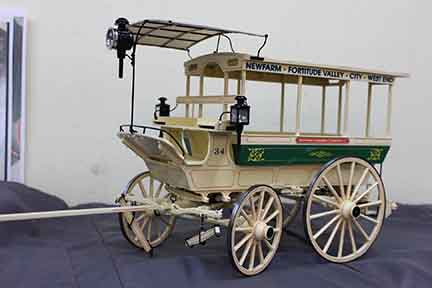 16 passenger omnibus
16 passenger omnibus
Made from drawings by J.E.Bishop. Graham describes this piece: Drawn by two horses and this type of vehicle was used as a local bus service, saw one on TV in an old short movie clip about Brisbane.
Looked OK, so I went and had a look for a drawing and B-I-N-G-O, had one in my stash of drawing, so it soon became a reality.
Used another full sized Garden Seat Omnibus that is in the Cobb & Co Museum in Toowoomba, as a reference for the color scheme, pin striping and scroll work.
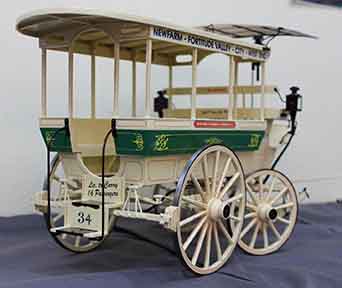
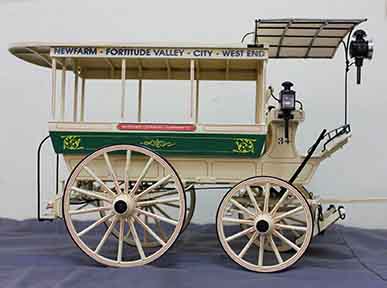
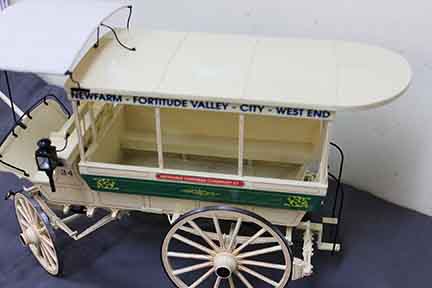
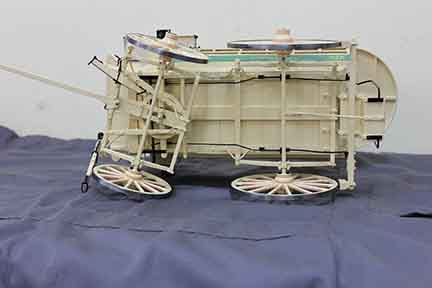
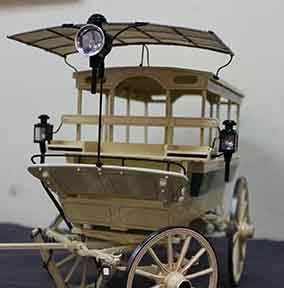
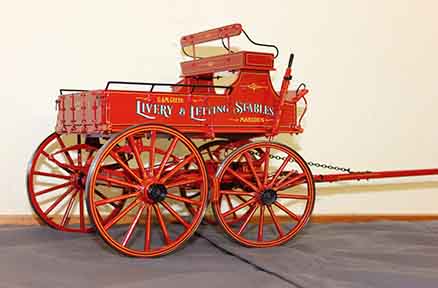 Country Storekeepers Wagon
Country Storekeepers Wagon
Made from drawings by J.E.Bishop. Graham describes this piece: Saw a picture of a similar vehicle on the back cover of a book called Tim Downers Legacy and reckoned it was OK.
Found out it was actually in the Museum at Millicent, South Australia, contacted them and got a bit more info.
Was out at a special farm day held at Mick Bradfords and he had one of these vehicles in rather poor condition on display, put two and two together and came up with this model.
Found the drawing the same as Mick’s wagon and used the color scheme and sign writing from the vehicle at Millicent, South Australia.
This vehicle could be used with a pair, or possibly at a pinch, as a Unicorn hitch, depends on how many horses the owner had or the weight being carted around and where he had to go.
A few photo’s showing the construction of this model are with-in.
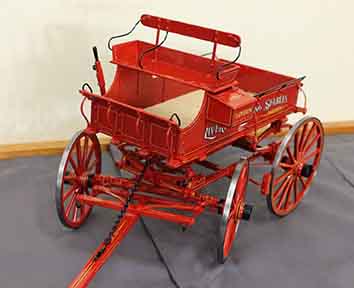
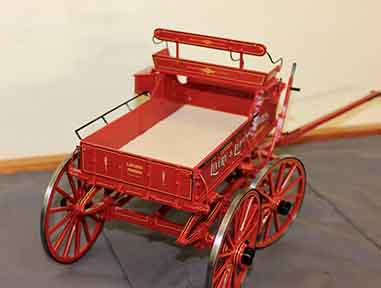
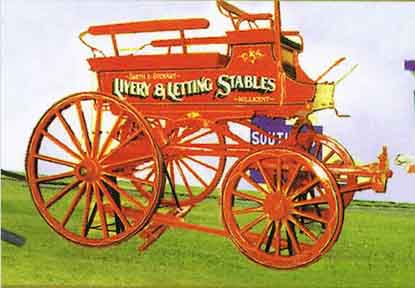 Original reference image (museum), plans and in progress images.
Original reference image (museum), plans and in progress images.
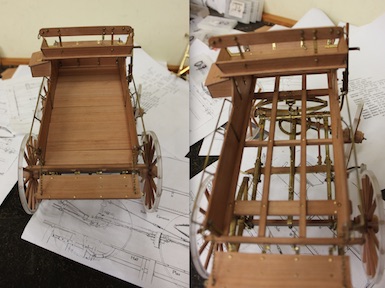
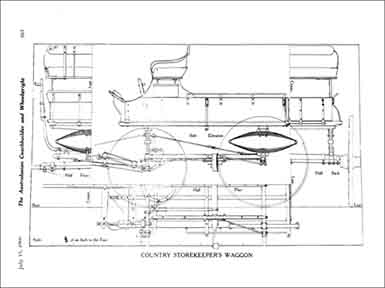
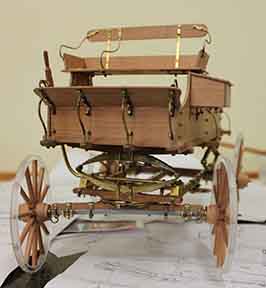
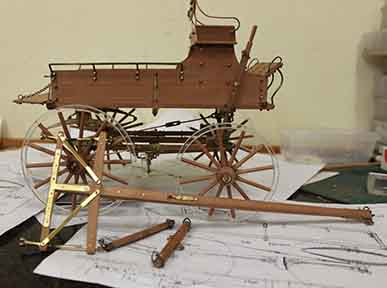
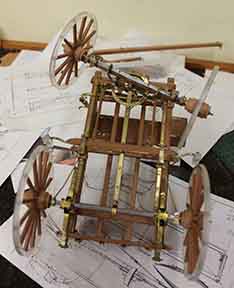
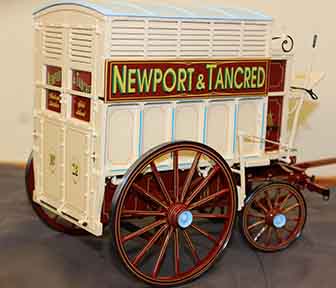 Sydney Meat Wagon
Sydney Meat Wagon
Made from drawings by J.E.Bishop. Normally drawn by two horses. Graham describes this piece: Saw a very old black and white photo of one of these vehicles, in the book called The Coachbuilder Atlas of Scale Drawings, even had the drawing for this vehicle in me stash of drawings.
Mentioned this to a fella who knows about horses and he said he had a photo of something very similar, it was being painted and repaired for a Sydney Royal Show, this color photo would have been taken about the middle of the 1960’s.
Liked the look of all this and had the drawing of a very similar vehicle, so started on it.
Used the color scheme and sign writing from the color pic and this model eventually appeared
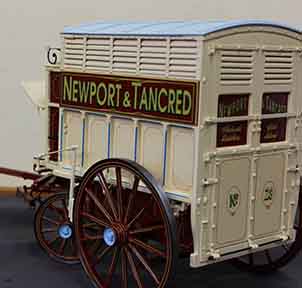
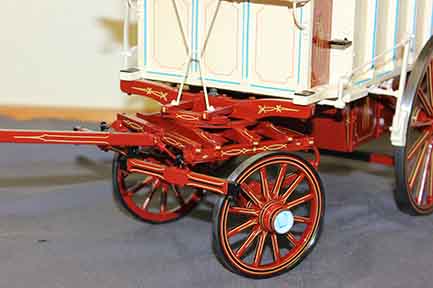
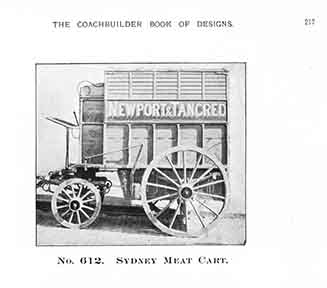
Refernces and in progress images.
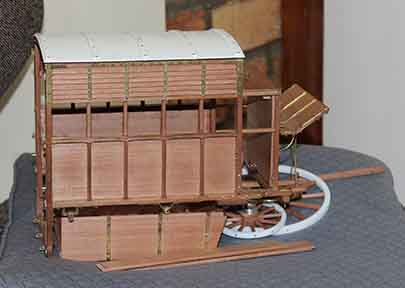
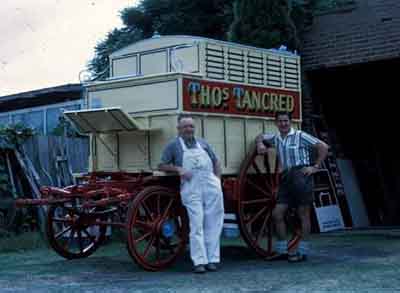
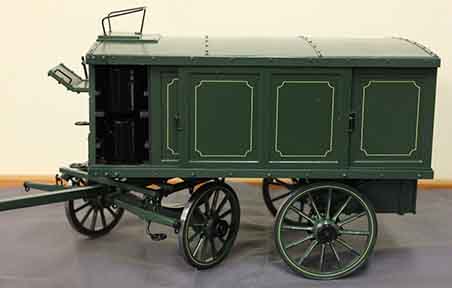 Sanitary Wagon
Sanitary Wagon
Made from drawings by J.E.Bishop. Normally drawn by two horses. Graham describes this piece: Got sick and tired of seeing half arsed so called carriage models, that were actually just plain bloody junk, being plastered all over the web, so whilst scrolling thru all my working drawings this thingie kind of drew my attention to it.
Couldn’t get any further away from them junkie carriages, —————————————— with what this thingie represents, eh. :-)
The best part about this model is that there are NO flies, or smell, hanging around, even made some 'dunny cans' for it as well.
Two horses would have been used once again and they had to be B-I-G ones, 'cause at the end of the run, it would have weighed quite a bit, eh.
These vehicles were very popular, every town had at least 1, the bigger the town, the more that were needed.
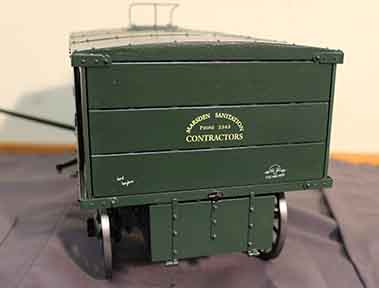
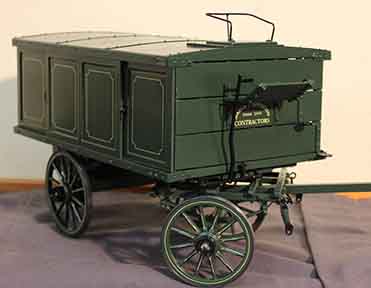
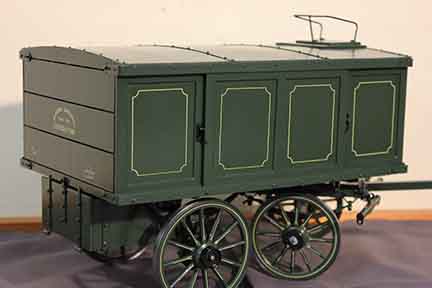
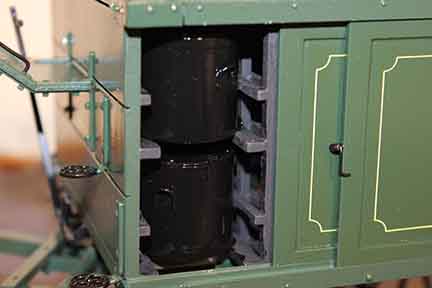
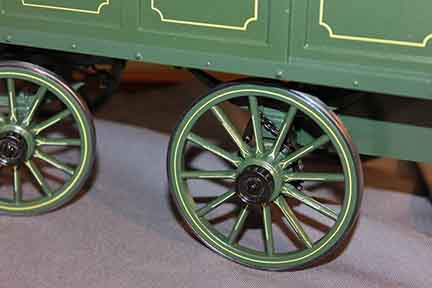
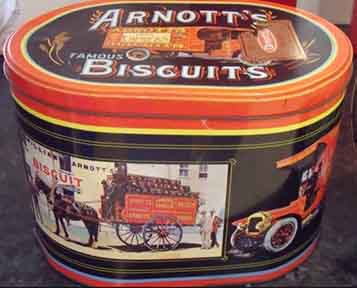 Spring Cart, Arnotts Biscuits
Spring Cart, Arnotts Biscuits
Made from own drawings. Normally drawn by one horse. Graham describes this piece: My wife, SWMBO, had acquired a biscuit tin many, many moons ago and every time I pulled it out of the cupboard I admired this vehicle.
Did a bit of research and found out just how big the tins are that’s on the vehicle, so out with the calculator and I started to get an idea of how big the vehicle actually was.
With a tad of help from a person who actually repairs and re-makes these old horse drawn vehicles, I made a drawing on what we had at hand and this eventuated.
The vehicle is actually being tarted up for some parade and had a photo taken of this event, looks like the photo would have been hand colored at a later date.
It is only drawn by 1 horse because biscuits are not that heavy when delivering them, even lighter is the return of the empty biscuit tins.
The load shown on the picture on the biscuit tin is all empties, just loaded up for the parade.
Gleaned that knowledge from the biscuit manufacture, as they are still operating in Australia, actually started operations way back in 1865
Just used the picture on the tin to do all the art work shown, tried to depict it as you can see it.
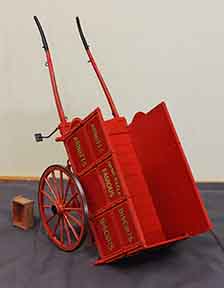
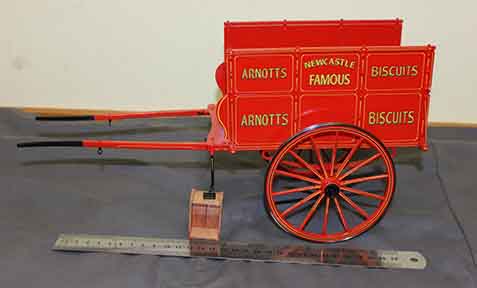
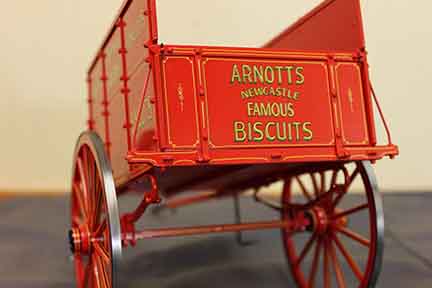
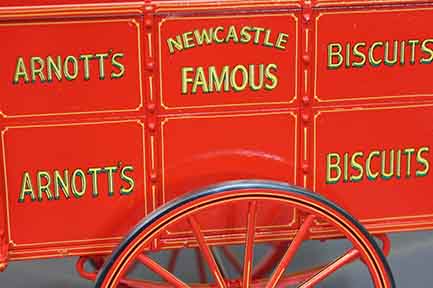
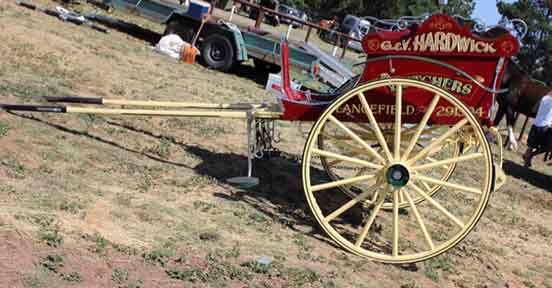 Butchers Light Order Cart
Butchers Light Order Cart
Made from drawings by J.E.Bishop. Normally drawn by one horse. Graham describes this piece: Saw a full sized vehicle and liked the look of it, I knew I had the drawing to make it and this it what appeared.
Used this original vehicle, in the first photo, for inspiration to do the art work, changed the colour to individualize it a bit.
These vehicles were used by many country butchers, to deliver meat to farms way out in the scrub/bush, the driver would deliver last weeks order and then get the order for the next week, whilst out at the farm.
There are quite a few variation on the shapes of the body of these vehicles, as each ‘Wainwright’ ( Carriage Builder ) would add his own touches to the vehicle he was making. Roughly the same size even though they look a bit different.
Only one horse required for this vehicle and it would have been something like the size of a modern day trotting horse.
They would be away from home overnight, so required a good strong, fast, easy going horse to do the job required
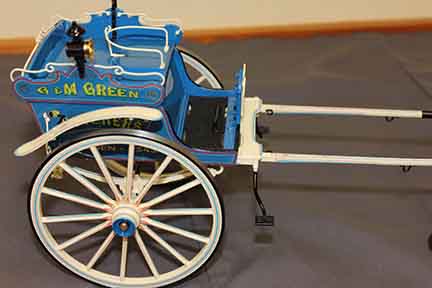
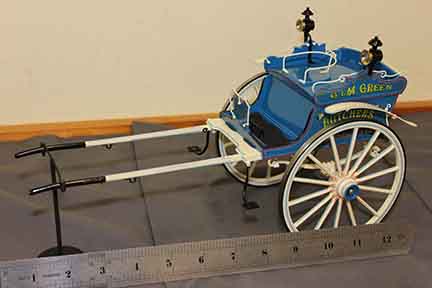
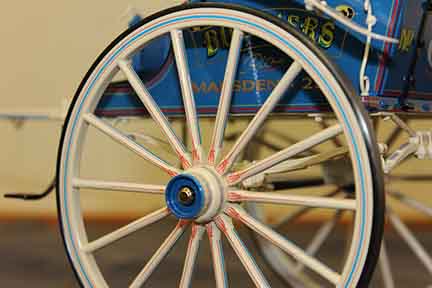
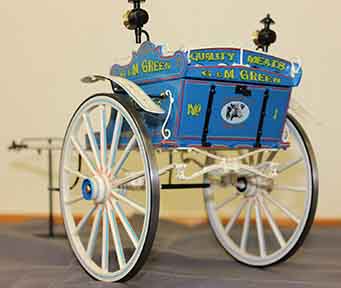
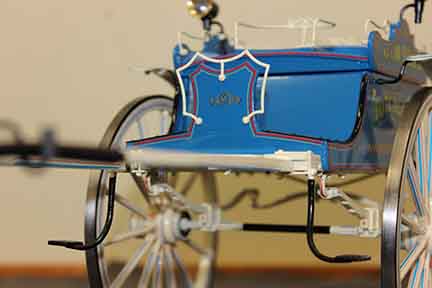
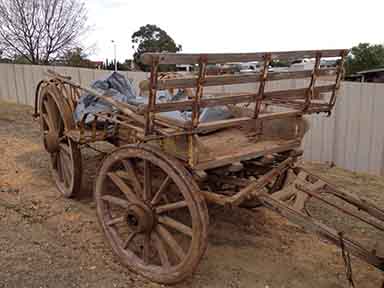 Bow Wagon
Bow Wagon
Made from drawings by J.E.Bishop. Normally drawn by two to eight horses. Graham describes this piece: Reason it’s called a Bow Wagon, is that it has the steel bows over the wheels, to stop the load from fouling the wheels.
Think a mobile hay stack, piled up about 20ft in the air, with the sides spilling out to about 12 ft wide and just about dragging on the ground.
A good sized Farm Wagon with very few frilly little girly features, just used by the ‘cockies' for very hard ‘Yakka”.
Saw one for sale on Ebay, liked the look of it, so swiped the pictures from the evil one and found the drawing in my stash and this eventuated/morphed onto my workbench.
Could have been used with 2, 4, 6 or even 8 ‘needies' to power this lot, all depended on what the ‘cocky’ had in mind that day. Just to move it empty, would require 2 HP.
It has NO suspension, just a rigid set-up, the body has been built right onto the heavy duty rear axle, turntable has no suspension either.
If you look closely at the first pic you can just make out the colour of the body and the colour of the undercarriage, as well as what’s left of the pin-striping.
Tried to copy all that lot onto the model.
Contacted the fella trying to sell it and showed him what I had made, he couldn’t believe what he was looking at, he was over the moon actually.
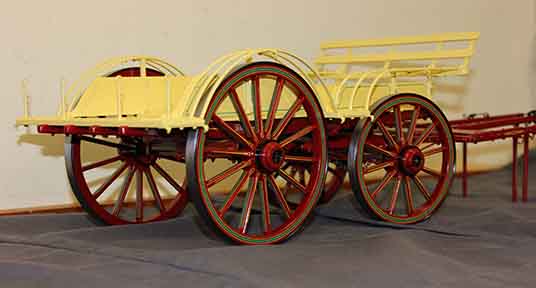
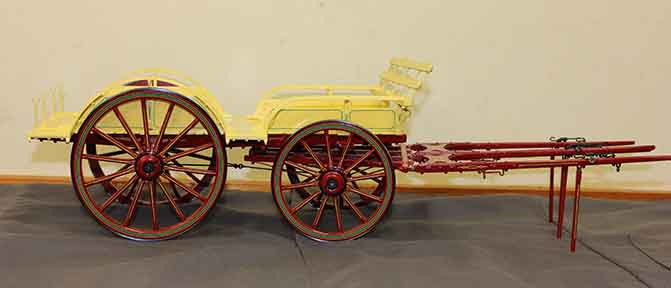
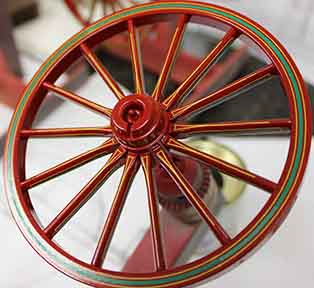
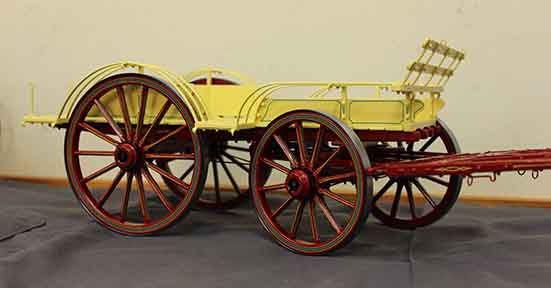
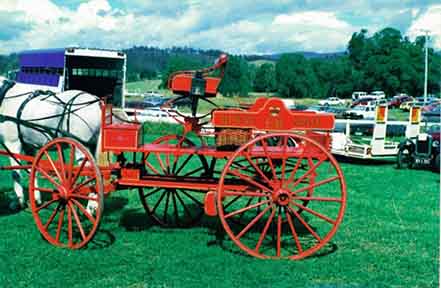 Buckboard Wagon
Buckboard Wagon
Made from own drawings. Normally drawn by five horses. Graham describes this piece: Australian version of the yankee buckboard, (we at least made it far more comfortable by adding springs).
Found a full sized vehicle that is in the first photo, so had to take hundreds of photos and heaps of measurements and then draw it to scale myself, made the model direct from those drawings.
Bit of history with this particular vehicle, it was found in a very old dilapidated shed out at a place called Yuleba, out west of Brisbane, on the road to Roma.
This full sized vehicle is the LAST horse drawn vehicle that was owned by Cobb & Co being used on the run from Yuleba to Surat. The train had come out to Roma but the mail still had to be delivered to Surat, so Cobb did this, it was the very last place in Queensland that Cobb & Co used horses.
They had bought one of them new fangled horseless carriages to do the mail run, not many passengers ever wanted to go that far out bush, so one new vehicle was bough and they kept this Buckboard Wagon as a back up, for if and when that cranky new fangled motor vehicle wouldn’t go. This Wagon was just shoved into a shed out at Yuleba and forgotten about for about 50/60 yrs, when a fella by the name of Bob Bone, who’s an avid collector of Horse drawn vehicles, stumbled across it and recognized it for what it was. So he bought it, transported it back to Brisbane and had it rejuvenated, somebody gave him some old Aust Post stickers that were used for the side of truck, so he thought they would look nice on the new red Wagon. They are the ER Royal Mail on the added bits of timber on the sides of the wagon. These stickers are of the period of Queen Elizabeth the 2nd, absolutely nothing to do with the period, of when this wagon would have been used.
With a good load onboard there would have been a 5 horse hitch used, typical Cobb & Co 5 horse hitch, as they needed to keep each team together as one lot, wether it be the Stagecoach or this parcel Wagon they were pulling. Bob only ever used two nags up front.But imagine this light weight Wagon going over a rough road, with 5 wild eyed needies flat out up front, scary, eh. ;-)
Used the full sized vehicle as the template for painting and all the scrollwork as well.
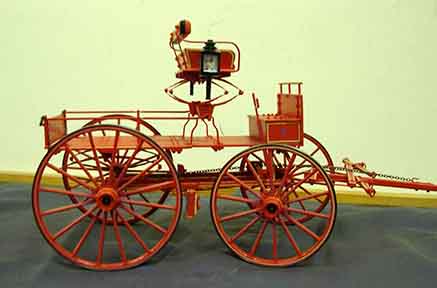
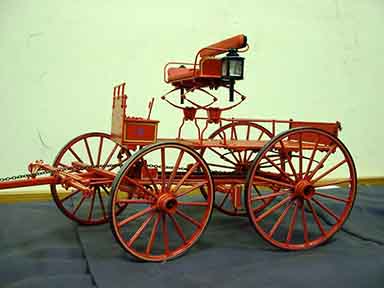
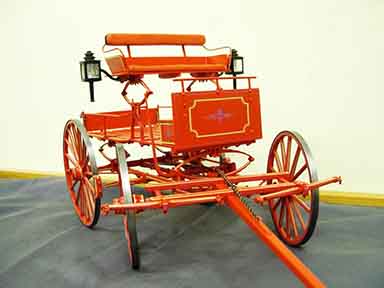
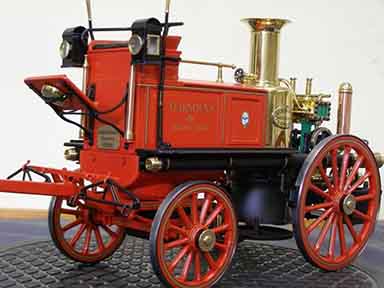 Shande Mason Steam Driven Fire Pumper
Shande Mason Steam Driven Fire Pumper
Made from the drawings of Edgar.T.Westbury. Normally drawn by two or three (unicorn hitch) horses. Graham describes this piece: I used the drawings of Edgar.T.Westbury to make this model, I acquired the drawings from the Guild of Model Wheelwrites, only problem was they stuck me with a 50 buck join up fee, before they would sell me the plans for another 30 bucks. Bloody dear plans, eh.
This model is made once again to 1/12th scale, it is NOT a miniature historically acute model at all, the drawings I used are for making a 1/6th scale working model steam driven pumper, so they are NOT a true representation of one of these vehicles, but the finished model looks OK to me.
It is NOT a steaming model at all, I figured it would be a bomb, if I added fire and put water under pressure and then some small thread in brass gave way, so it’s just something to look at in the cupboard.
Used a lot of timber and brass once again, acrylic came to the fore as well, you can see what has been used in a couple of photo’s.
The way this is set-up, 2 horses, or, even 3 with a Unicorn set-up would have been used to power at around.
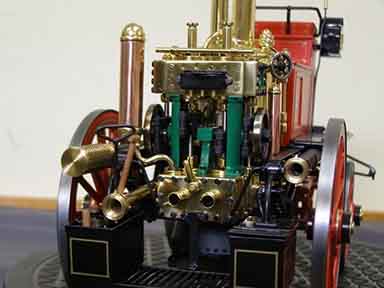
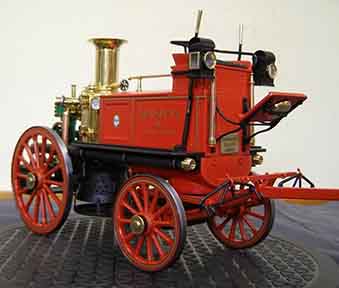
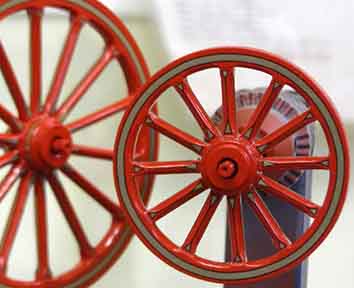
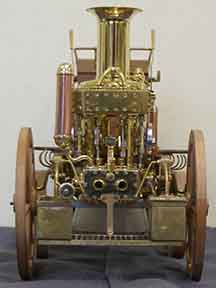
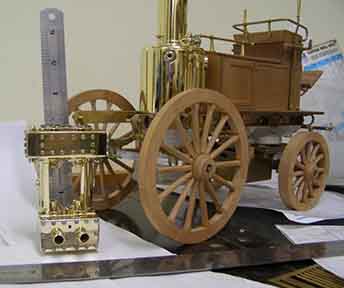
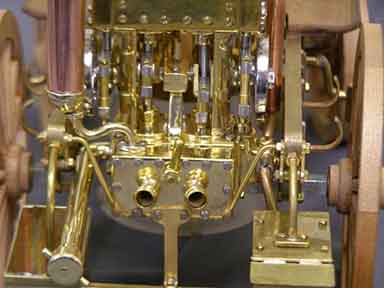
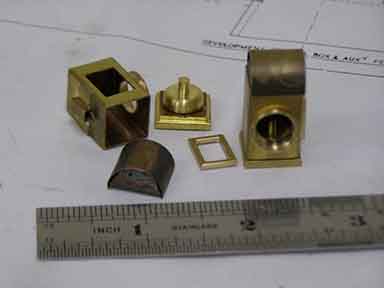
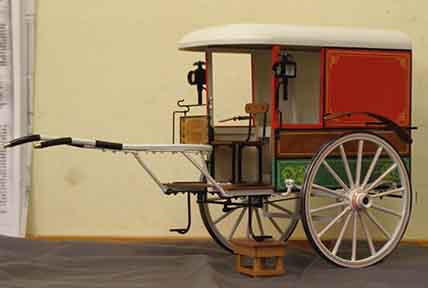 Business cart
Business cart
Made from the drawings of J.E. Bishop. Normally drawn by one horse. Graham describes this piece: One poverty looking horse would have been used as an 'around town clown', or city delivery vehicle and the owner would not spend too much on the nags upkeep judging from lots of old photos.
Normal things used to make this, timber, brass and whatever else I could scrounge to make it.
Tried painting it with a strip of clear coated timber in the middle of the sides and the mudguards clear coated as well, looks OK to me.
Nothing special about this one, it’s what it is, just a model!
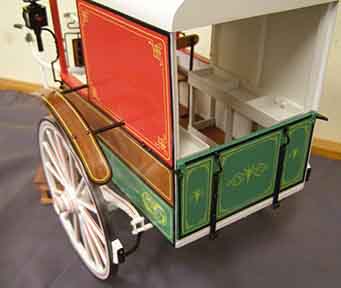
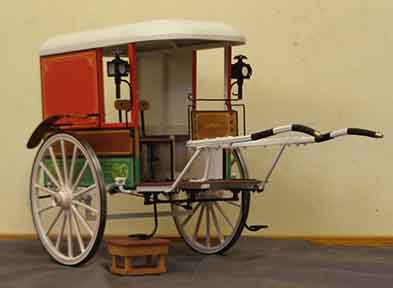
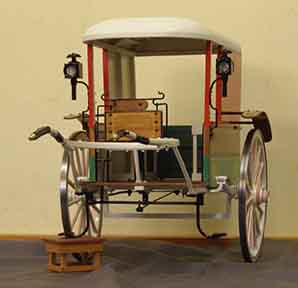
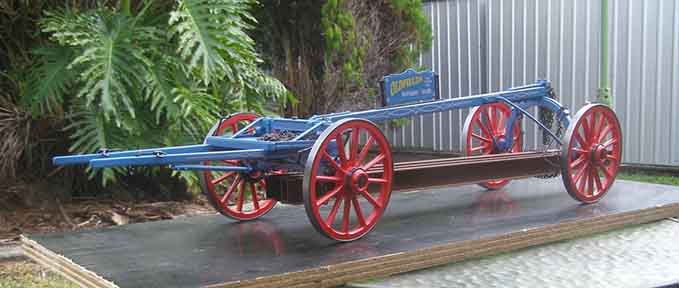 Log or Steel Jinker
Log or Steel Jinker
Made from the drawings of J.E. Bishop. Normally drawn by one or more horses (tandem). Graham describes this piece: These vehicles were used to pull timber from the forest and a lot were made, a few variants along the way, but all basically doing the same thing, hauling logs.
About the turn of the 20th century they started to make buildings using a steel framework, they were able to make buildings even higher than with just plain brickwork.
So these vehicles got a new lease of life hauling around the city and surrounds, steel beams for these new type of buildings.
Made this from the drawings of J.E.Bishop and then added the steel beams, gave it a updated look, rather than the scruffy looking things from out of the scrub.
It would have been powered by one horse with a light load, extra ‘needies' needed with more weight on it, all single file, so as to get around in narrow lanes if they had too.
Saw picture of one of these vehicles loaded with beams like the model, had the drawing, so got at it.
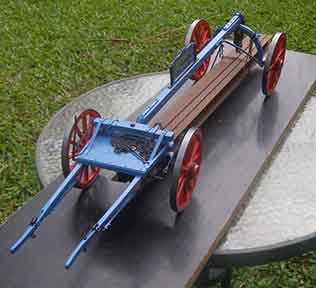
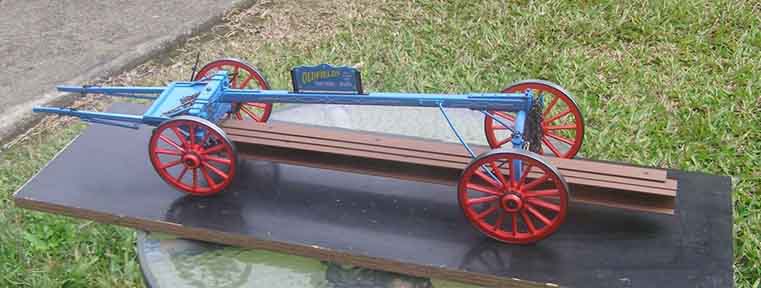
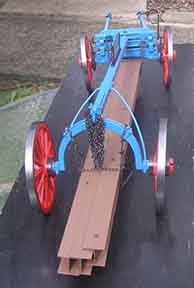
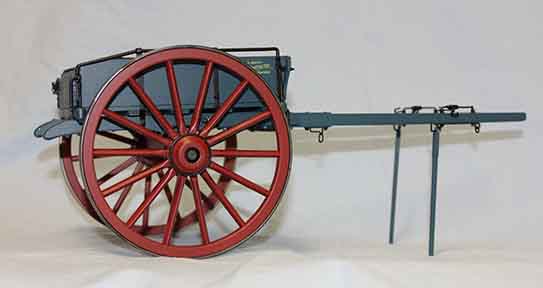 Rigid Tipping Dray
Rigid Tipping Dray
Made from the drawings of J.E. Bishop. Normally drawn by one horse. Graham describes this piece: These were the type of vehicles that actually built Australia, they were extensively used for many deca, on all sorts of major or minor projects.
It wasn’t until that new fangled invention that would never last, called a motor vehicle, became popular did these vehicles then start to decline.
Made to 1/12th scale as per all the others.
If you notice that there is NO suspension on this vehicle model, that’s why they are called a RIGID Dray.
Oh, have a look at all the nuts and bolts in their correct placement, that’s why I will call these models Historically accurate, not like a lot of other model makers, who use that term very loosely.
Everything is made to scale and in it’s exact place, all the hardware is where it’s supposed to be, as per the original drawings that I have used.
Made from the drawings of J.E.Bishop once again, with lots of different photo’s used for reference, then this was created.
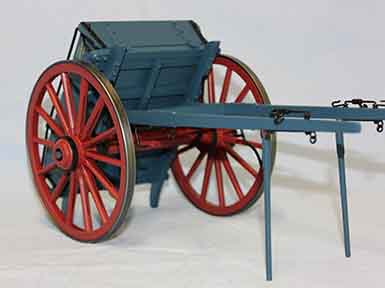
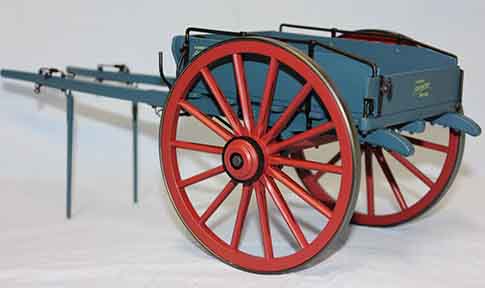
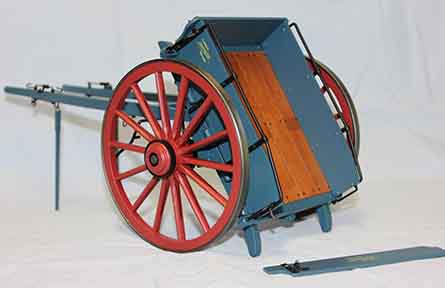
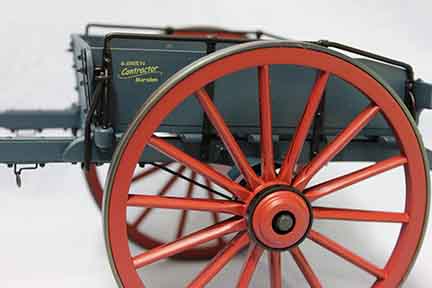
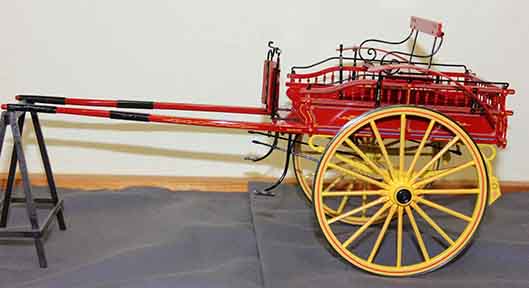 Spring Dray - called a "Masher Dray" in South Australia
Spring Dray - called a "Masher Dray" in South Australia
Made from the drawings of J.E. Bishop. Normally drawn by one horse. Graham describes this piece: This particular type of vehicle seemed to be very popular in South Australia, somehow it had acquired the very unusual name of a Masher Dray, be buggered if I can work out why it was called such a name. It’s still only a Spring Dray though.
Saw another spring dray at the Royal Brisbane Show, the EKKA, is it’s nickname, because it’s held at the Exhibition Grounds in Brisbane.
This particular vehicle appealed to me, I knew I had the drawing to make it, so took heaps of photo’s for reference and then into it.
Paint is ENAMEL once again and all art work, pin striping, is done with that magical machine, the ALPS MD 5500 printer and then applied to the model as decals.
I use CorelDraw to create the designs, before sending them to the printer to do it’s job.
Note the spindles all down the side of the vehicle, these are made from sewing pins, with very small glass beads super glued onto them.
The pins are then all cut at a certain length so as the beads will all be at the same height, placed into holes on the top edge of the timber, the top rail is made from brass with lots of small holes drilled into as well, to take the top of the pins.
Have a REAL good look at this one too, you’ll soon see that it’s Historically correct as per the ORIGINAL drawing I used, make sure you note that about ALL these models of mine.
It might shake up a few model builders to make them try a lot harder, before calling the stuff they make Historically correct.
Most, if not all the models you see for sale, are just made to a price, then they add that sales blurb and lots of gullible persons believe what they hear and see, without doing ANY research at all.
If anybody actually did some research on these other models, they would soon see that they are just toys and only made to a set price, shame isn’t it?
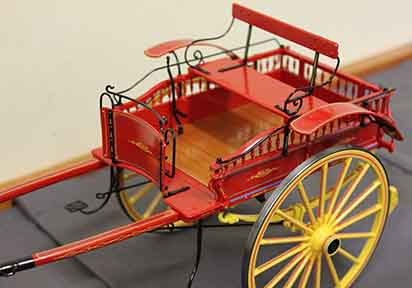
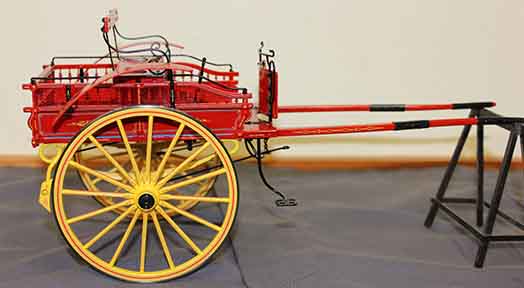
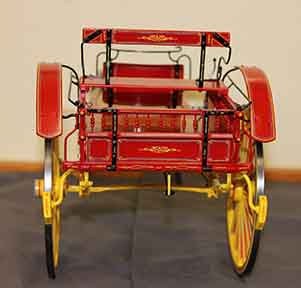
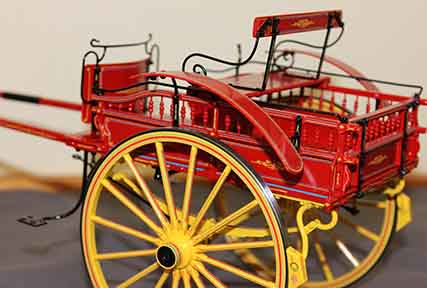
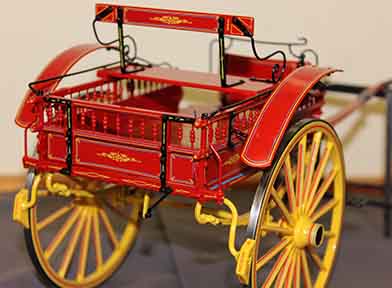
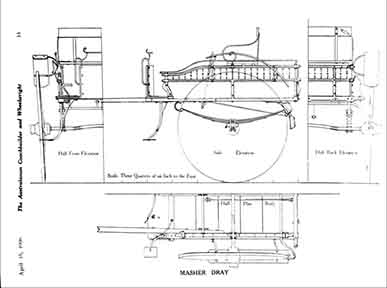
 Return to
Model Horse Gallery Home Page
Return to
Model Horse Gallery Home Page
This page was created by and is maintained by the Model Horse Gallery Curator. ©1996-2020

 raham Green is from Brisbane, Australia. Included in this gallery is a small selection of 1/12th scale Model Horse Drawn Vehicles that he has made.
They are all totally scratch built, using what ever medium he can get his hands on to make them, that will look OK when the model is finished.
raham Green is from Brisbane, Australia. Included in this gallery is a small selection of 1/12th scale Model Horse Drawn Vehicles that he has made.
They are all totally scratch built, using what ever medium he can get his hands on to make them, that will look OK when the model is finished. 16 passenger omnibus
16 passenger omnibus




 Country Storekeepers Wagon
Country Storekeepers Wagon






 Sydney Meat Wagon
Sydney Meat Wagon



 Sanitary Wagon
Sanitary Wagon




 Spring Cart, Arnotts Biscuits
Spring Cart, Arnotts Biscuits



 Butchers Light Order Cart
Butchers Light Order Cart




 Buckboard Wagon
Buckboard Wagon


 Shande Mason Steam Driven Fire Pumper
Shande Mason Steam Driven Fire Pumper






 Business cart
Business cart


 Log or Steel Jinker
Log or Steel Jinker


 Rigid Tipping Dray
Rigid Tipping Dray



 Spring Dray - called a "Masher Dray" in South Australia
Spring Dray - called a "Masher Dray" in South Australia




